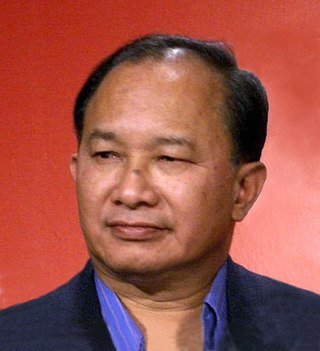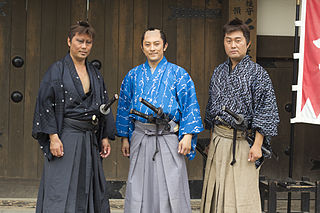
Akira Kurosawa was a Japanese filmmaker and painter who directed thirty films in a career spanning over five decades. He is widely regarded as one of the most important and influential filmmakers in the history of cinema. Kurosawa displayed a bold, dynamic style, strongly influenced by Western cinema yet distinct from it; he was involved with all aspects of film production.

The cinema of Japan has a history that spans more than 100 years. Japan has one of the oldest and largest film industries in the world; as of 2021, it was the fourth largest by number of feature films produced. In 2011 Japan produced 411 feature films that earned 54.9% of a box office total of US$2.338 billion. Films have been produced in Japan since 1897, when the first foreign cameramen arrived.

John Woo Yu-Sen SBS is a Hong Kong filmmaker, known as a highly-influential figure in the action film genre. He was a pioneer of heroic bloodshed films and the gun fu genre in Hong Kong action cinema, before working in Hollywood films. He is known for his highly chaotic "bullet ballet" action sequences, stylized imagery, Mexican standoffs, frequent use of slow motion and allusions to wuxia, film noir and Western cinema.
Martial arts films are a subgenre of action films that feature numerous martial arts combat between characters. These combats are usually the films' primary appeal and entertainment value, and often are a method of storytelling and character expression and development. Martial arts are frequently featured in training scenes and other sequences in addition to fights. Martial arts films commonly include hand-to-hand combat along with other types of action, such as stuntwork, chases, and gunfights. Sub-genres of martial arts films include kung fu films, wuxia, karate films, and martial arts action comedy films, while related genres include gun fu, jidaigeki and samurai films.

Masaki Kobayashi was a Japanese film director and screenwriter, best known for the epic trilogy The Human Condition (1959–1961), the samurai films Harakiri (1962) and Samurai Rebellion (1967), and the horror anthology Kwaidan (1964). Senses of Cinema described him as "one of the finest depicters of Japanese society in the 1950s and 1960s."

Seven Samurai is a 1954 Japanese epic samurai drama film co-written, edited, and directed by Akira Kurosawa. The story takes place in 1586 during the Sengoku period of Japanese history. It follows the story of a village of desperate farmers who hire seven rōnin to combat bandits who will return after the harvest to steal their crops.

Action film is a film genre in which the protagonist is thrust into a series of events that typically involve violence and physical feats. The genre tends to feature a mostly resourceful hero struggling against incredible odds, which include life-threatening situations, a dangerous villain, or a pursuit which usually concludes in victory for the hero.

Toshiro Mifune was a Japanese actor who appeared in over 150 feature films. He is best known for his 16-film collaboration (1948–1965) with Akira Kurosawa in such works as Rashomon, Seven Samurai, The Hidden Fortress, Throne of Blood, and Yojimbo. He also portrayed Miyamoto Musashi in Hiroshi Inagaki's Samurai Trilogy and one earlier Inagaki film, Lord Toranaga in the NBC television miniseries Shōgun, and Admiral Isoroku Yamamoto in three different films.

Rashomon is a 1950 Jidaigeki psychological thriller/crime film directed and written by Akira Kurosawa, working in close collaboration with cinematographer Kazuo Miyagawa. Starring Toshiro Mifune, Machiko Kyō, Masayuki Mori, and Takashi Shimura as various people who describe how a samurai was murdered in a forest, the plot and characters are based upon Ryunosuke Akutagawa’s short story "In a Grove", with the title and framing story being based on "Rashōmon", another short story by Akutagawa. Every element is largely identical, from the murdered samurai speaking through a Shinto psychic to the bandit in the forest, the monk, the assault of the wife and the dishonest retelling of the events in which everyone shows his or her ideal self by lying.

Takashi Shimura was a Japanese actor who appeared in over 200 films between 1934 and 1981. He appeared in 21 of Akira Kurosawa's 30 films, including as a lead actor in Drunken Angel (1948), Rashomon (1950), Ikiru (1952) and Seven Samurai (1954). He played Professor Kyohei Yamane in Ishirō Honda's original Godzilla (1954). For his contributions to the arts, the Japanese government decorated Shimura with the Medal with Purple Ribbon in 1974 and the Order of the Rising Sun, 4th Class, Gold Rays with Rosette in 1980.

The cinema of Hong Kong is one of the three major threads in the history of Chinese language cinema, alongside the cinema of China and the cinema of Taiwan. As a former British colony, Hong Kong had a greater degree of political and economic freedom than mainland China and Taiwan, and developed into a filmmaking hub for the Chinese-speaking world.
Hu Jinquan, better known as King Hu, was a Chinese film director and actor based in Hong Kong and Taiwan. He is best known for directing various wuxia films in the 1960s and 1970s, which brought Hong Kong and Taiwanese cinema to new technical and artistic heights. His films Come Drink with Me (1966), Dragon Inn (1967), and A Touch of Zen (1970–1971) inaugurated a new generation of wuxia films in the late 1960s. Apart from being a film director, Hu was also a screenwriter and set designer.

Ishirō Honda was a Japanese filmmaker who directed 44 feature films in a career spanning 59 years. The most internationally successful Japanese filmmaker prior to Hayao Miyazaki, his films have had a significant influence on the film industry.

Kamatari Fujiwara was a Japanese actor.
Asian cinema refers to the film industries and films produced in the continent of Asia. However, in countries like the United States, it is often used to refer only to the cinema of East Asia, Southeast Asia and South Asia. West Asian cinema is sometimes classified as part of Middle Eastern cinema, along with the cinema of Egypt. The cinema of Central Asia is often grouped with the Middle East or, in the past, the cinema of the Soviet Union during the Soviet Central Asia era. North Asia is dominated by Siberian Russian cinema, and is thus considered part of European cinema.

Masaru Sato was a Japanese composer of film scores. Following the 1955 death of Fumio Hayasaka, whom Sato studied under, Sato was the composer of Akira Kurosawa's films for the next 10 years. He was nominated for Best Music at the 15th Japan Academy Prize in 1992. In 1999, the Japanese government decorated Sato with the Order of the Rising Sun, 4th Class, Gold Rays with Rosette for his contributions to the arts.

Fumio Hayasaka was a Japanese composer of classical music and film scores.

Chanbara (チャンバラ), also commonly spelled "chambara", meaning "sword fighting" films, denotes the Japanese film genre called samurai cinema in English and is roughly equivalent to Western and swashbuckler films. Chanbara is a sub-category of jidaigeki, which equates to period drama. Jidaigeki may refer to a story set in a historical period, though not necessarily dealing with a samurai character or depicting swordplay.

Nagamasa Kawakita was a Japanese entrepreneur, film producer and importer. Together with his wife Kashiko Kawakita and daughter Kazuko Kawakita, he was instrumental in the development of the Japanese film industry, sponsoring actors and actresses, and in promoting Japanese cinema to overseas audiences.
Fumio Yanoguchi was a Japanese recording engineer known for his work with film director Akira Kurosawa.

















